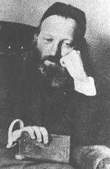What is the spiritual significance of these two activities: climbing
and standing?
Moving (walking, climbing, etc) and standing are the two principle
functions of legs. Each is a metaphor for a type of divine service.
Movement indicates spiritual ascent, both in terms of intellectual
enlightenment and refinement of character. Torah study in particular is
associated with spiritual progress, and is called 'the path'. "One who
does not constantly increase [his knowledge] -
decreases it." [Avot I:13]
When we move, our legs are separate. But when we stand, our legs are
joined together. To stand is to internalize that which has been acquired,
to reinforce those spiritual acquisitions deeply in the soul, so that
these gains will not be lost in some change in situation or trial of life.
This retention and internalization of spiritual accomplishments is the
function of prayer. For this reason we pray standing, legs united, like
the angels. The prophet describes the angels as having legs united and
straight [Ez 1]. Angels do not grow in holiness. Their
very essence is one of maintaining a certain level of spiritual
perfection. When we pray, we are emulating this angelic stance, being at
one with our spiritual state.
In addition, standing indicates an effortless, natural position. This
is the level of the angels, effortless in their holiness. In prayer, we
aim to establish our spiritual attainments as natural to our level. In
Torah study, on the other hand, we attempt to gain higher levels, to
ascend God's mountain, by virtue of our free will and effort.
[Ayn Aya I:61]
"Who shall climb God's mountain? Who
shall stand in His holy place?" [Ps
24:3]
Climbing and Standing
